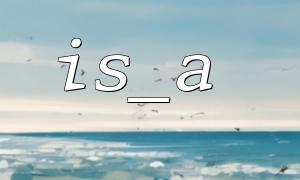In PHP development, it is often encountered that you need to determine whether a class implements a certain interface. Although PHP provides multiple ways to achieve this requirement, combining is_a() and interface_exists() functions can make detection more accurate and safe. This article will introduce in detail the role of these two functions and their combined use methods.
The is_a() function is used to determine whether an object is an instance of a certain class or interface. Its syntax is as follows:
bool is_a(object|string $object_or_class, string $class_name, bool $allow_string = false)
$object_or_class : can be an object instance or class name (when the third parameter is true).
$class_name : The class or interface name to be detected.
$allow_string : Whether to allow the first parameter to be the string class name.
Example:
class MyClass implements MyInterface {}
interface MyInterface {}
$obj = new MyClass();
var_dump(is_a($obj, 'MyInterface')); // bool(true)
is_a() can directly determine whether an object implements an interface, or it can also determine the inheritance relationship between a class and an interface.
The interface_exists() function is used to determine whether an interface has been defined. The syntax is as follows:
bool interface_exists(string $interface_name, bool $autoload = true)
$interface_name : Interface name.
$autoload : Whether to allow automatic loading of interfaces (default true).
Example:
if (interface_exists('MyInterface')) {
echo "The interface exists";
} else {
echo "The interface does not exist";
}
This function checks whether the interface exists before calling is_a() , which can avoid errors caused by undefined interfaces.
When using is_a() alone to judge, if the interface does not exist, it will lead to unexpected results. To avoid this situation, it is recommended to use interface_exists() to confirm whether the interface is defined, and then use is_a() to determine the realization relationship.
Sample code:
$className = 'SomeClass';
$interfaceName = 'SomeInterface';
if (interface_exists($interfaceName)) {
if (is_a($className, $interfaceName, true)) {
echo "$className Implemented the interface $interfaceName";
} else {
echo "$className No interface is implemented $interfaceName";
}
} else {
echo "interface $interfaceName Does not exist";
}
The point here is:
interface_exists() ensures that the interface exists.
The third parameter is_a() is set to true , allowing the first parameter to be a class name string.
Combining these two functions avoids potential errors when the interface does not exist.
Suppose we have the following interface and class:
interface LoggerInterface {
public function log($message);
}
class FileLogger implements LoggerInterface {
public function log($message) {
echo "Log to file: $message";
}
}
We want to determine whether the class FileLogger implements LoggerInterface :
$class = 'FileLogger';
$interface = 'LoggerInterface';
if (interface_exists($interface)) {
if (is_a($class, $interface, true)) {
echo "$class Implemented the interface $interface";
} else {
echo "$class No interface is implemented $interface";
}
} else {
echo "interface $interface Does not exist";
}
Output:
FileLogger Implemented the interface LoggerInterface
Make sure the interface name and class name are spelled correctly.
is_a() allows the class name string to be passed when the third parameter is true .
If only object instance is_a() is passed, the third parameter defaults to false .
Use interface_exists() to prevent errors caused by undefined interfaces.
By using is_a() and interface_exists() in combination, you can more securely and accurately determine whether a class implements the specified interface. This approach is suitable for dynamic type checking in large projects, ensuring the robustness of the code.














